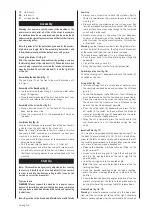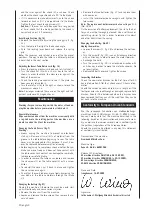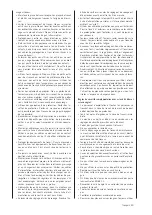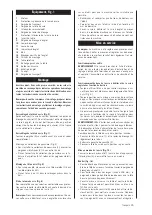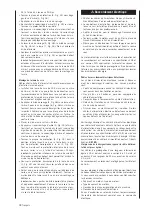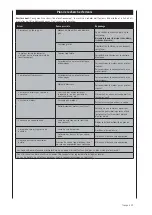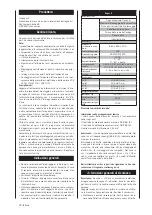
english 19
• Cuts due to the cable being driven over.
• Insulation defects due to being pulled out of a wall sock
-
et.
• Cracks due to the aging of the insulation.
Such defective electrical connections should not be used
and are, due to their damaged insulation, mortally danger-
ous!
Electric connecting cable should be checked regularly for
damage. See that when the cables are checked they are
not live. Electrical connections must correspond to the ap
-
propriate VDE and DIN norms and the local electrical regu
-
lations. Only use extension leads with the label H 07 RN.
All extension leads must have the type printed on them
according to law! Extension leads up to 25 metres long
must have a crosssection of 1.5 square millimetres; for
those longer than 25 metres, a cross-section of at least 2.5
square millimetres is required.
The connection to the power source is secured with a 16A
carrier.
Connections and repairs to the electrical equipment should
only be carried out by an electrical specialist. Should there
be questions, the following Information is relevant:
• motor manufacturer, motor type
• type of current the motor uses
• data on the machine and type signs
• data for the electrical drive.
Should the motor be returned, it should be sent as a com-
plete unit.
Through poor conditions of the electrical MAINS, shortly
voltage drops
• can appear when starting the EQUIPMENT. This can in
-
fluence other equipment (e.g. blinking of a lamp).
• If the MAINSIMPEDANCE Zmax < 0.27 OHM, such dis
-
turbances are not expected.
(In case of need, you may contact your local supply author
-
ity for further information).
Means of Correction
Adjustment of the slanting board (fig. 8, 9, 10, 11)
Note: In order to maintain an exact saw cut, before begin-
ning the operation the position should be checked and, if
necessary, adjusted.
90°-Position (fig. 8, 9, 12)
• Release the clamping lever (4, fig. 12) and position the
saw unit at 90°, while the chock lever (4, fig. 9) is in the
pressed down position.
• Put the angle gauge on the bevelling table with one side
against the table and the other against the saw blade.
• Should the angle gauge not lie exactly flat along the saw
blade, release the four positioning screws (1, fig. 8) on
the back of the body with a 5 mm Allen key. Pull the
chock roughly 17.5 mm backwards so that it just passes
through the cast part (2) of the back of the body.
• Tilt the arm to the left until it clicks, without touching
the chock. Put the gauge on the table and bring the head
slowly to 90°. Do not go past this point. Should this hap
-
pen, tilt the saw head down again and bring it to 90°.
• Position the clamping lever and tighten the four sixsid
-
ed bolts after the adjustments have been made.
Indicator Position for the Saw Blade Slant (fig. 9)
Once the position for 90° has been achieved, adjust the in
-
dicator (2) so that it points to 0° on the sliding scale (3). To
do this release the indicator screw (1) with a screwdriver,
adjust the dial and then tighten the screw again.
Chock adjustment for 45° to the left (fig. 9, 10, 12)
• Push the sliding chock (19, fig.1) completely to the left,
and then pull the slant locking mechanism (1, fig. 10)
forward.
Please note: when you wish to pull the chock back it may
be necessary to shift the upper sawing arm to the left or
the right in order to release the holding pressure.
• Release the clamping lever (4, fig. 12) and tilt the saw
arm completely to the left.
• Use an angle gauge and check whether the saw blade is
at a 45° angle to the table.
• For positioning, tilt the saw arm to 0°, release the safety
nut (5, fig.10), and turn the screw (6, fig 10) one way
or the other in order to Increase or reduce the angle (fig.
9).
• Tilt the saw arm back to the left and check the posi
-
tion.
• Repeat these steps until the blade is at a 45° angle to
the table. Once this is achieved, tighten the safety bolt
(5, fig. 10) in order to secure the chock screw.
Chock adjustment for 45° to the Right (fig. 9, 10, 12)
Repeat the steps described above for the right side.
33.9° Slanted Position (fig. 11)
• Place the bevel angle at 0°. Position both of the plate
chocks outward.
• Release the clamping lever (4, fig.12) and tilt the saw
arm to the chock 33.9° by pushing the chock peg back
-
wards.
• Use the angle gauge to check whether the blade is posi
-
tioned at an angle of 33.9° to the table.
• To install, turn the screw thread with an Allen key (see
arrow, fig. 11) until the blade is set at an angle of 33.9°
to the table.
• Repeat these steps for the slant angle of 33.9° on the
right side.
Bevel Angle Position / Spring Chock Position (fig. 12)
The bevel scale shows a bevel angle from 0° to 45° to the
left and from 0° to 60° on the right. The most usual angle
slits have spring positions in order to make it easier to
achieve a quick and precise positioning:
• Raise the spring grip and thereby unlock the table.
• Move the rotating table while raising the spring grip (1)
in order to set the indicator (2) at the desired angle.
• Lock the table into the desired position by releasing the
spring grip.
Bevel Scale Indicator (fig. 12)
• Put the table into the 0° position.
• Use a screwdriver to release the screw (3) which holds
the indicator.
• Adjust the indicator (2) to the marking for 0° and tighten
the screw.
Positioning the Blade to the Chock (fig. 13)
• Turn the upper arm to the 0° position and ratchet it in.
• Loosen the four chock locking screws (1) with a turn of
the Allen key until the chock (2) is loose.
• Move the saw head down and lock it there with the chock
peg.
• Place the back of the angle gauge (3) against the blade,
Содержание 8800 1945
Страница 120: ...118 international 17 ...
Страница 121: ...international 119 ...
Страница 122: ...120 international ...












